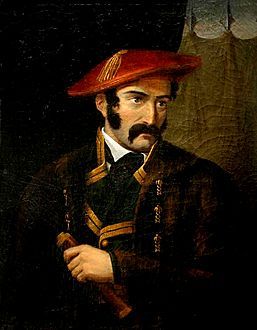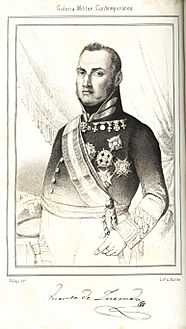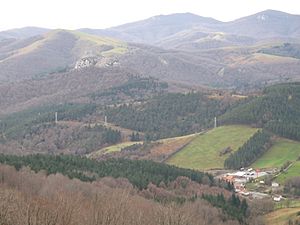Battle of Alsasua facts for kids
Quick facts for kids Battle of Alsasua |
|||||||
|---|---|---|---|---|---|---|---|
| Part of First Carlist War | |||||||
|
|||||||
| Belligerents | |||||||
|
Carlists supporting |
Liberals (Isabelinos or Cristinos) supporting Isabella II of Spain and her regent mother Maria Christina |
||||||
| Commanders and leaders | |||||||
| Tomás de Zumalacárregui | Vicente Genaro de Quesada | ||||||
| Casualties and losses | |||||||
| 200 dead and wounded | 450 dead and wounded and 400 prisoners, including the capture of a full infantry company. | ||||||
The Battle of Alsasua, also known as the Battle of Altsasu, happened on April 22, 1834. It took place in Navarre, Spain, during the First Carlist War. Carlist general Tomás de Zumalacárregui attacked a group of soldiers and supplies (called a convoy) led by Liberal general Vicente Genaro de Quesada. This convoy was traveling from Vitoria-Gasteiz to Pamplona and passed through the town of Alsasua.
The Liberal forces suffered many losses. General Zumalacárregui captured many soldiers and a large amount of money. This battle was important because of how prisoners were treated. Both generals decided to treat captured soldiers very harshly after they couldn't agree on a prisoner exchange. This set a difficult tone for how prisoners would be handled throughout the war. The battle also made it harder for Liberal forces to get supplies in the area. It was part of Zumalacárregui's successful guerrilla (hit-and-run) campaign.
Contents
What Led to the Battle?
This battle was one of the first major fights in the First Carlist War. This war was about who would be the next ruler of Spain. On one side was Infante Carlos, who wanted to be king. On the other side was his niece, Isabella II of Spain, who was supported by her mother, Queen Maria Christina.
The Carlists were people who wanted to keep old traditions and supported Carlos. They mostly had support in the Basque region, Navarre, and parts of eastern Spain. They didn't have much help from other countries.
The Isabelinos, or Liberals, supported Isabella. They controlled most of the kingdom and had more soldiers and supplies. They also controlled the main government. However, they had brought in new, modern ideas that many people didn't like, especially during a tough economic time. Because of this, the Carlists had strong support from ordinary people in the areas where the war was fought.
Given these facts, the Carlists decided to use a strategy called guerrilla warfare. This meant they would raid supply convoys, set up ambushes, and use their knowledge of the local land to defeat the Liberals whenever they could. The Battle of Alsasua was a key part of this strategy.
Alsasua's Location
Alsasua is a town located about 41 kilometers (25 miles) east of Vitoria-Gasteiz. It's also about 85 kilometers (53 miles) west of Pamplona. The town sits between mountains that separate the Álava and Pamplona areas. One writer described it as the "largest town in Navarre."
There were other routes General Quesada could have taken. He could have gone north through the Basque Mountains or south through other mountains or a longer path. However, there's no mention that Quesada thought about other routes. The Carlists also seemed sure of the path the convoy would take. This geography made it likely that the two sides would have a direct fight, known as a pitched battle.
Before the Fight
The battle happened after a period of calm in the Navarre war zone. Both sides were busy gathering supplies and making their forces stronger. On April 1, General Zumalacárregui promised rewards to his soldiers for brave actions. Carlos, the Carlist leader, even wrote a personal letter supporting this a week later.
Zumalacárregui and Quesada had fought each other many times before. Zumalacárregui's guerrilla strategy often involved smaller fights and attacks on convoys. These usually resulted in dozens, or up to 200, soldiers lost on each side. One source noted how much marching these battles involved. Soldiers on both sides were "always in movement." Quesada thought he could win by chasing the Carlists without rest. Zumalacárregui began to feel the pressure of this constant pursuit.
Quesada's Convoy
On April 21, Quesada left Vitoria with a group of soldiers. This group included two infantry battalions, one grenadier battalion, a sniper company, and cavalry units. They were carrying 500,000 gold reals to pay Liberal troops in Navarre. Because there weren't many soldiers available, his forces were not very strong compared to the valuable goods they were carrying.
Before leaving Vitoria, Quesada had ordered General Lorenzo Fernández to send more troops to reinforce the convoy. These reinforcements were supposed to meet him in Salvatierra the next morning. Quesada stayed overnight in Salvatierra, waiting for Fernández's troops, but they never arrived. He then marched to Alsasua.
General Quesada expected an attack near Alsasua. However, he didn't know that the reinforcements he needed wouldn't show up. He later blamed this for his defeat. Fernández's troops were busy helping another officer fight Carlists elsewhere. Quesada's scouts couldn't give him much information about Zumalacárregui's forces until they reached the town. Still, seeing few farmers on his way made him take "necessary precautions."
Zumalacárregui had spent the night in Etxarri-Aranatz. He had eight battalions under his command, with four of them joining him that same night.
The Battle Begins
On the morning of April 22, Zumalacárregui sent fifty cavalrymen to scout and act as bait for Quesada. His main troops waited in ambush in the woods near the towns of Ciordia and Olazagutia. However, Quesada was very aware that an ambush was possible. After looking at maps and talking with his officers, he changed his formation.
His leading troops (the vanguard) would go first. But the convoy's supplies (the baggage train), artillery, and cavalry would take a different path. They would go through a makeshift bridge on the left side to reach a clear area. This way, they hoped to surprise the Carlists themselves. Quesada knew that retreating or delaying the fight was not an option in this difficult terrain.
The fight started soon after. Quesada's forces were greatly outnumbered. They were in a "critical condition" within an hour of fighting. However, his vanguard managed to hold off the Carlists well enough. This allowed the rest of his forces to reach a better position. But the land was rough, and soldiers had to cross several streams with water up to their thighs. Finally, they reached the Etzegarate pass.
Quesada set up his forces in a half-circle shape. Most of his troops and a second battalion of local volunteers covered the main path from Zumalacárregui. Two sections of the Royal Guard Infantry and 40 carabiniers guarded the top of the hill. He placed his artillery in the center of the half-circle. Behind it were the convoy's baggage, cavalry, and a battle hospital. The Carlist forces attacked many times. They managed to take control of the hill for a short time but couldn't keep it. This allowed Quesada to retreat towards Villafranca, though he lost his baggage in the process.
What Happened After the Battle?
Quesada couldn't retreat back to Vitoria because Carlist forces blocked the way. He had to hike through the mountains to Gipuzkoa with fewer than 150 men to avoid more fighting. He didn't arrive in Pamplona until April 27. Leopoldo O'Donnell, a commander of the Royal Guard, was among those captured by the Carlists.
After the battle, Zumalacárregui spent the night at Echarri. He gave orders for many of the captured Liberal soldiers to be treated very harshly. He said this was in response to the "inhumane conduct" of the Liberal government, which had been treating captured Carlists as criminals. He threatened to treat the remaining 100 prisoners severely if Carlists were not treated as proper prisoners of war. Some officers were allowed to avoid this harsh treatment, but it's not clear how.
Zumalacárregui and Quesada tried to arrange an exchange of prisoners, but they couldn't agree. Quesada did not see the Carlists as honorable enough to negotiate with. He even called Zumalacárregui "chief of the bandits." Quesada also threatened to harm the families of Carlist soldiers if his officers weren't released. Zumalacárregui thought these threats were wrong because the families "were foreign to the struggle." He announced his response, and the harsh treatment of prisoners continued on both sides. Two days after the battle, Zumalacárregui praised his troops, especially the 1st Navarrese battalion.
The battle cut off Pamplona from supplies coming from Vitoria. This left the capital of Navarre open to attacks and sieges throughout the war.
See also
 In Spanish: Batalla de Alsasua para niños
In Spanish: Batalla de Alsasua para niños





